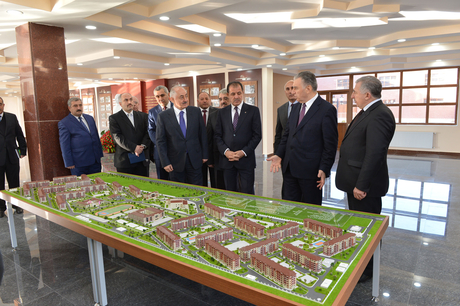Residential complex built for 1500 IDP families in Ganja

By Sara Rajabova
The Azerbaijani government has built a complex of new many-storied residential buildings for 1500 internally displaced persons' (IDP) families in Ganja as part of the measures carried out to support refugees and IDPs displaced during the brutal war with Armenia in the early 1990s.
The complex was built in accordance with the "State Program on Improvement of living conditions of refugees and IDPs and their employment opportunities" approved by the presidential order in July 2004.
The ceremony to inaugurate the complex was held on December 22. Deputy Prime Minister, Chairman of the State Committee for Affairs of Refugees and IDPs Ali Hasanov, head of Ganja Executive Authority Elmar Valiyev, head of Kalbajar Executive Authority Agil Mammadov and other officials attended the event.
Addressing the ceremony, Hasanov said the Azerbaijani state always paid huge attention to improvement of living conditions of refugees and IDPs.
He said the improvement of living conditions of IDPs were one of key principles in President Ilham Aliyev`s policy.
Hasanov noted that state programs had been adopted and important measures had been taken to improve material wellbeing of IDPs.
He said construction of the new complex for 1500 IDP families were brilliant example of the care and attention by the government.
The complex covering 25 hectares includes twenty-five 5-storied residential buildings and other necessary social infrastructure facilities.
Some 1400 families from Kalbajar, and 100 families from Aghdam, Jabrayil, Fuzuli, Lachin, Shusha, Zangilan, Khojali and Khojavand districts will be settled in new buildings.
Out of 1500 apartments 150 have one room, 650 two rooms, 550 three rooms and 150 four rooms. The complex also has 1200-seat school, 280-bed kindergarten, 500-seat House of Culture, as well as an administrative building for Kalbajar local authorities, medical center and automatic telephone exchange.
The construction of the complex in Ganja started in March 2013 and ended in September 2013. The new complex was built at the request of the Social Development Fund for IDPs.
Hasanov earlier said such buildings will be constructed in Absheron, Imishli, Garadagh, Ismayilli, Balaken and Gabala regions of Azerbaijan.
The bloody war, which flared up in the late 1980s due to Armenia's territorial claims against its South Caucasus neighbor, left 700,000 civilians in Nagorno-Karabakh and the regions adjoining it, as well as the regions bordering with Armenia and Nagorno-Karabakh, without permanent places of residence. They are temporarily settled in 62 cities and regions of Azerbaijan in more than 1,600 settlements.
Moreover, 250,000 Azerbaijanis were expelled from Armenia and became refugees due to Armenia's ethnic cleansing policy as the Nagorno-Karabakh conflict with Azerbaijan emerged.
The Azerbaijanis who were displaced from their homes as result of the brutal war had to live in refugee camps, tents and wagons, in very difficult conditions.
The Azerbaijani government made the refugee and IDP problem its high priority and prepared numerous projects and programs in order to improve the living conditions of the refugees. The people who held refugee status were granted compensations and benefits. Extensive measures were initiated to ensure social protection of the refugees since Azerbaijan's oil strategy began to bear fruit.
Sixty-seven settlements and new private homes for 20,000 families were built for temporary residence of refugees and IDPs in 2001-2010 as part of the efforts to improve their living conditions.
The Azerbaijani government continues taking measures to resolve the social problems of the refugees and IDPs. Every year, a large amount of funds is allocated for this purpose from the state budget, the State Oil Fund, the state energy firm SOCAR and other sources.
